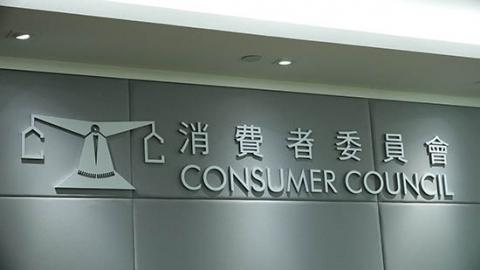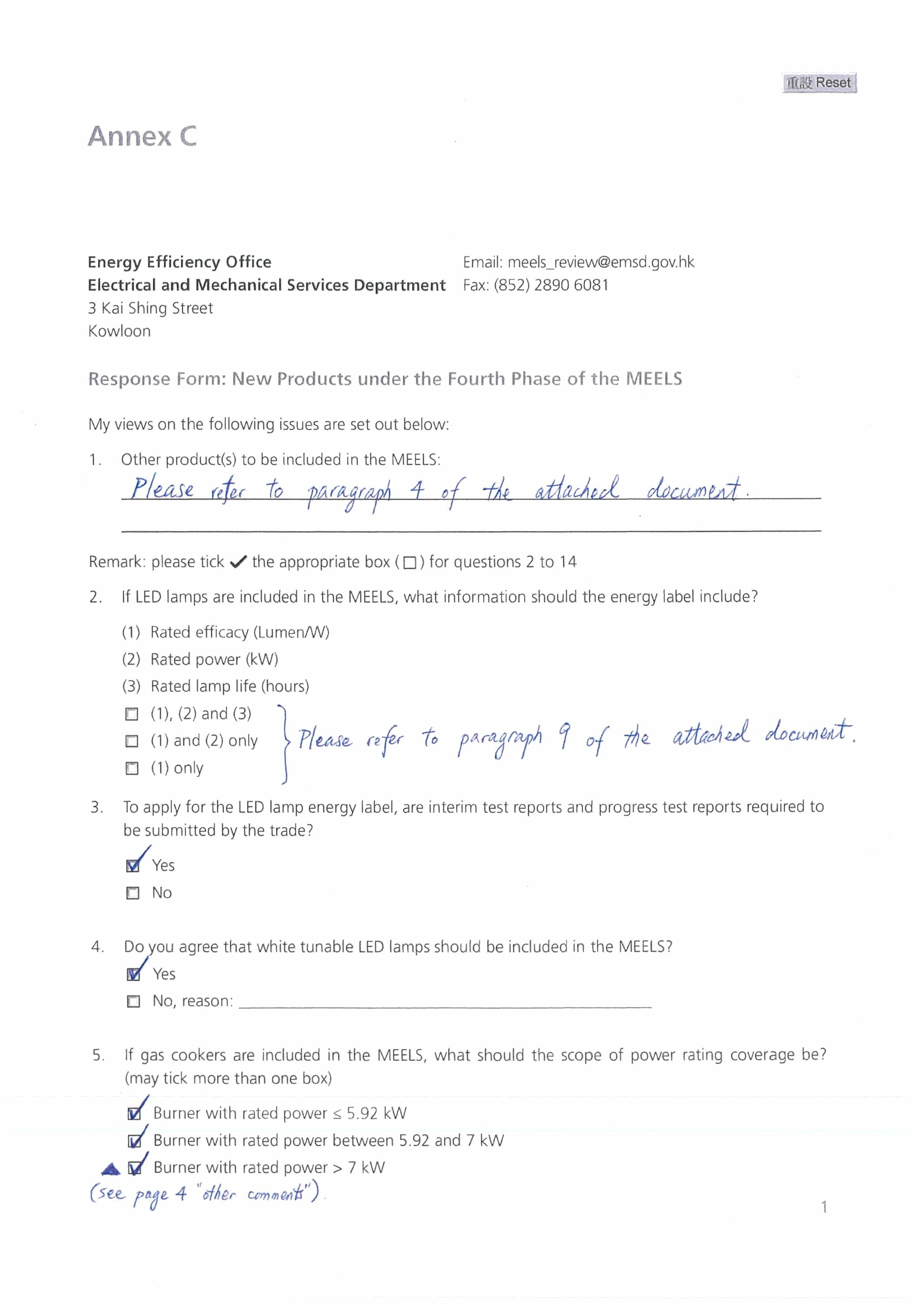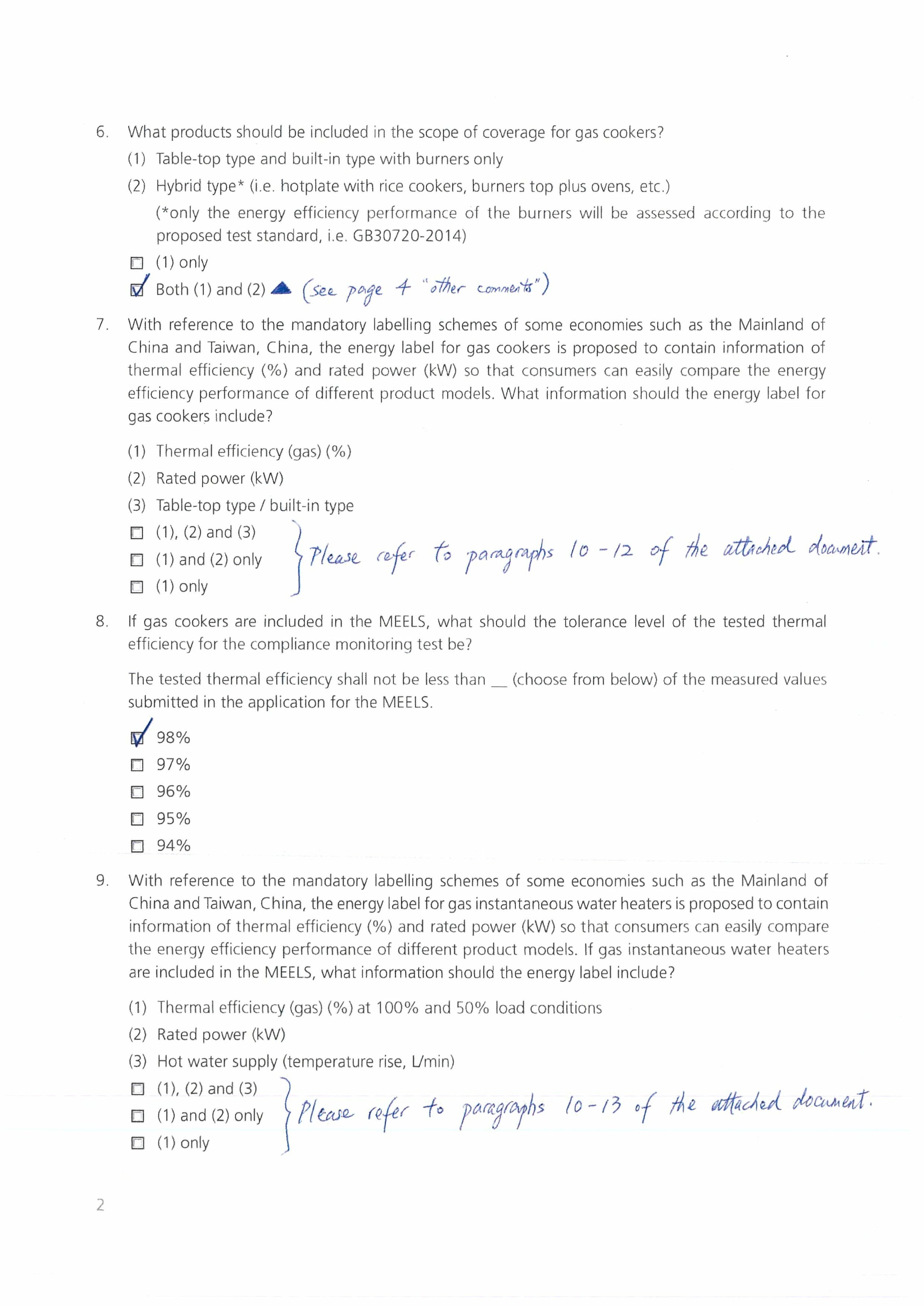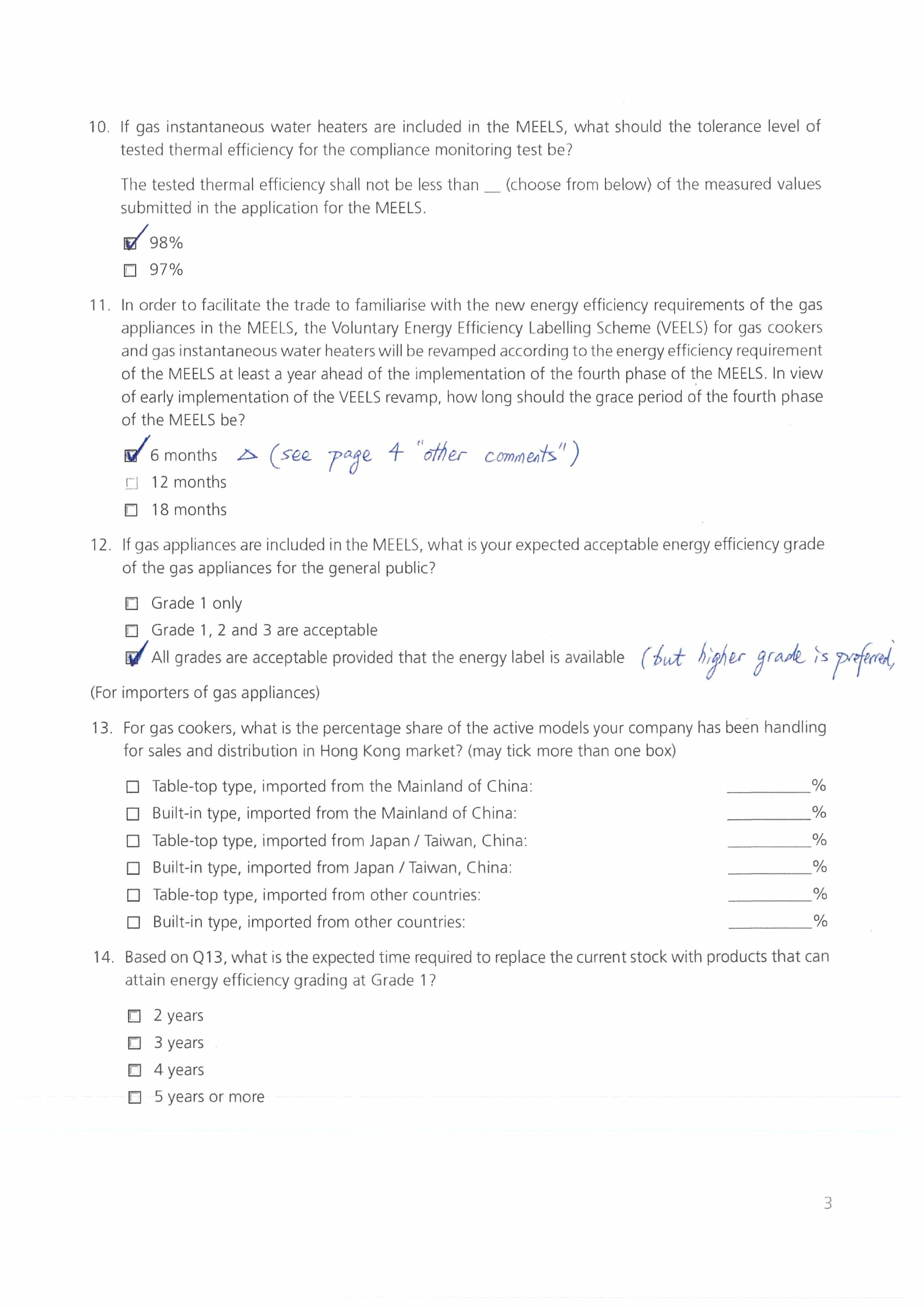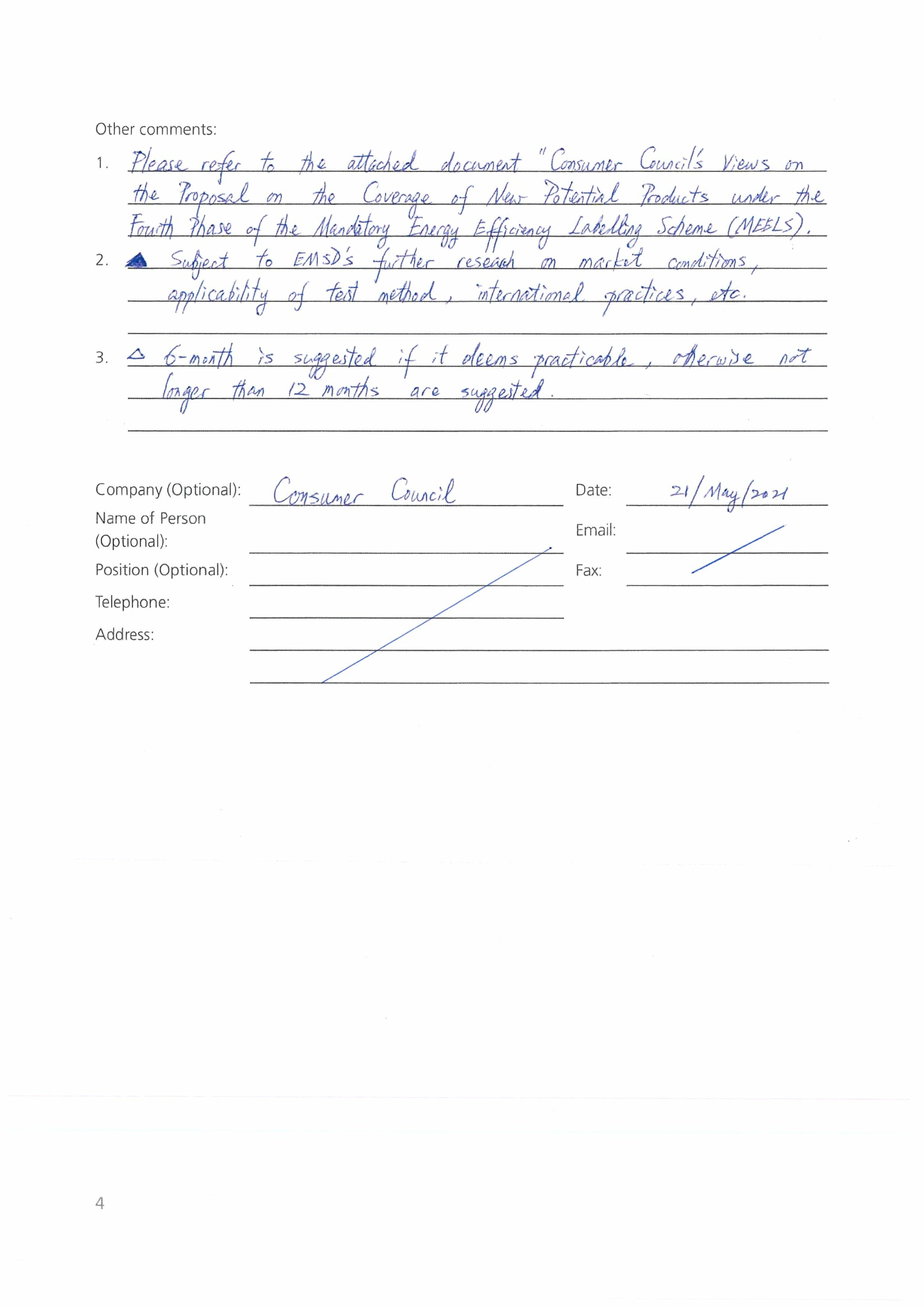- The Consumer Council (“CC”) supports the Electrical and Mechanical Services Department’s proposal on extending the scope of the Mandatory Energy Efficiency Labelling Scheme (MEELS) to include light-emitting diode (LED) lamps, gas cookers and gas instantaneous water heaters. CC considers that expanding the coverage of the MEELS to a wider range of products available to consumers will enable them to make purchase decisions with energy conservation in mind. This in turn will encourage product suppliers to develop and market more energy-efficient products for local consumers. It will also help promote the concept of sustainable consumption and steer consumer behaviour towards sustainability in the long run.
- LED lamps, gas cookers and gas instantaneous water heaters are currently covered in the Voluntary Energy Efficiency Labelling Scheme (VEELS), in which "grading type" energy label is used for LED lamps while "recognition type" energy label is used for gas cookers and gas instantaneous water heaters. CC supports the proposal of using "grading type" energy label when these 3 product types are included in the MEELS, since "grading type" energy labelling is more informative and can facilitate comparison.
- CC suggests that more stringent grading thresholds be adopted whenever feasible so as to provide meaningful differentiation between products of different levels of energy efficiency performance, and drive product suppliers to develop and market more energy-efficient products. Moreover, considering future advances in energy-saving technology, the adoption of more stringent grading thresholds at the commencement can reduce the frequency of upgrading the thresholds in the future. CC suggests that the grading thresholds, especially those for the top Grade 1, as well as other relevant performance requirements be at least comparable with those currently adopted in other advanced economies such as the Mainland China and the European Union whenever applicable. Besides, any plan of upgrading of thresholds in other advanced economies should be closely monitored, so as to avoid lagging behind other advanced economies when the fourth phase of the MEELS takes effect (targeted to be commenced in Q2 2023).
- In addition to those 3 product types covered in the proposal, CC considers that other product types of relatively high energy consumption or commonly used by consumers, e.g. electric fans, electric room heaters, electric rice cookers, microwave ovens etc., should also be explored to be included in the MEELS in the further phases. Moreover, apart from household products, high energy-consuming products such as passenger cars (in particular electric cars) should also be seriously visited and have a clear inclusion roadmap in the further phases.
- With regards to the 8 prescribed products currently covered under the MEELS, CC suggests that their grading thresholds should be reviewed and upgraded in due course. For instance, CC observed that for washing machines, as of May 2021, if excluding the listed models that are no longer being supplied in the market according to the relevant product suppliers, almost all (around 95%) of the remaining models of washing machines are of Grade 1. CC considers that it is time to tighten its grading thresholds so as to enhance the effectiveness of the scheme in helping consumers to choose energy efficient models.
- Besides the above-mentioned comments and those in the response form, some further comments specifically in relation to LED lamps, gas cookers and gas instantaneous water heaters are outlined below.
LED Lamps
- Regarding the test condition for LED lamps, CC suggests that the tests should be conducted at the voltage and frequency of mains electricity in Hong Kong (i.e. 220V, 50Hz), no matter the model’s rated voltage is 220V or 220-240V etc. In fact, all 8 prescribed products (including compact fluorescent lamps) currently covered under the MEELS are tested at the voltage and frequency of mains electricity in Hong Kong. CC suggests that LED lamps follow the same principle.
- CC had published a comparative test report on 10 models of LED lamps in the March 2020 issue of CHOICE magazine, in which variations in performances were found among the tested models. For instance, the test found that after 6,000 hours of operation, only 2 models maintained their initial luminous flux, while the others dropped by 1.1% to 6.2%. Since it takes long time (more than 8 months) to complete the 6,000 hours test for LED lamps, CC supports the proposal of acceptance of interim test report. Considering that lumen maintenance is crucial to the quality and longevity of LED lamps, CC supports that the acceptance criteria of interim lumen maintenance is included to assess the performance of LED lamps.
- Referring to question 2 of the response form, CC suggests that the efficacy (lm/W), luminous flux (lm) and lifespan (hours) of LED lamps should be included on the energy label. The luminous flux represents the brightness of LED lamps, and consumers can compare the luminous flux instead of the rated power (W) when choosing the brightness of LED lamps. The lifespan is one of the major important factors when consumers consider to purchase LED lamps.
Gas Cookers and Gas Instantaneous Water Heaters
- In the proposed design of energy labels for gas cookers and gas instantaneous water heaters, the gas type (i.e. LPG or town gas) is not shown. CC is of the view that gas type is an essential information for consumers when choosing gas appliances. Moreover, CC observed that in the EMSD’s approved list of domestic gas appliances, some manufacturers use the same model number for both LPG and town gas versions of their products, even though the two versions’ specifications (e.g. rated power) are different. For example, two gas cookers (or two gas instantaneous water heaters) of the same brand, model number as well as appearance are in fact different in gas type and specifications, and their energy efficiency performances might be different as well. As such, there is a possible scenario where two gas cookers (or two gas instantaneous water heaters) are of the same brand, model number as well as appearance but bear different energy labels showing different energy efficiency grades, thermal efficiencies and/or rated power, causing confusion to consumers. Therefore, CC suggests adding the gas type information on the energy labels for both types of gas appliances, so as to facilitate consumers to distinguish more easily whether the information on the energy label is referring to the model’s LPG version or town gas version.
- CC supports the proposal of showing the thermal efficiency (in %) on the energy labels for both types of gas appliances, so that consumers would be able to compare the energy efficiency performances between different models of the same product type, even when their energy efficiency grades are the same.
- CC also supports the proposal of showing the rated power (in kW) on the energy labels for both types of gas appliances. Considering that some gas cookers have more than one burner, and the rated power of these burners could be different, CC suggests that the respective rated power of each burner should be clearly shown on the energy label.
- When it comes to gas instantaneous water heaters, hot water production capacity (or called hot water supply), which is commonly expressed in the unit of litre/min at 25°C water temperature rise, is a key parameter for consumers to choose a suitable model. Therefore, CC suggests adding the rated hot water production capacity on the energy label for gas instantaneous water heaters.



